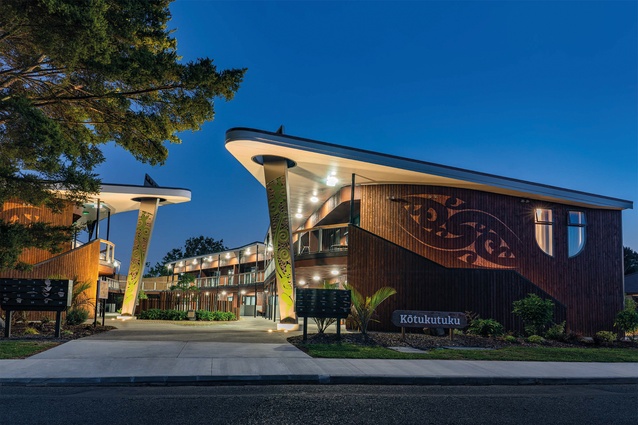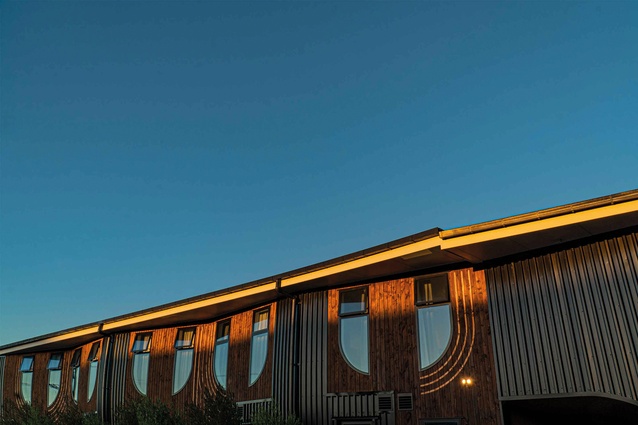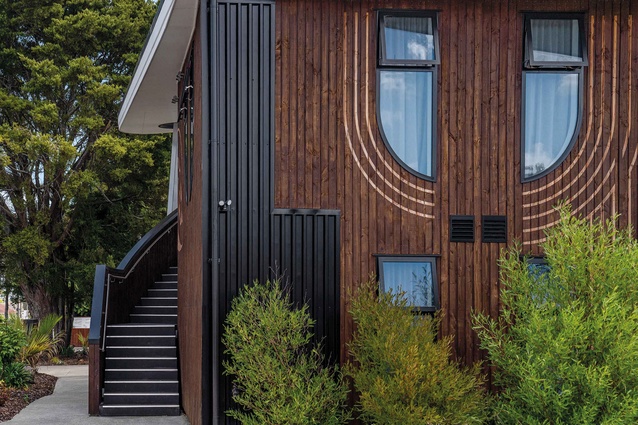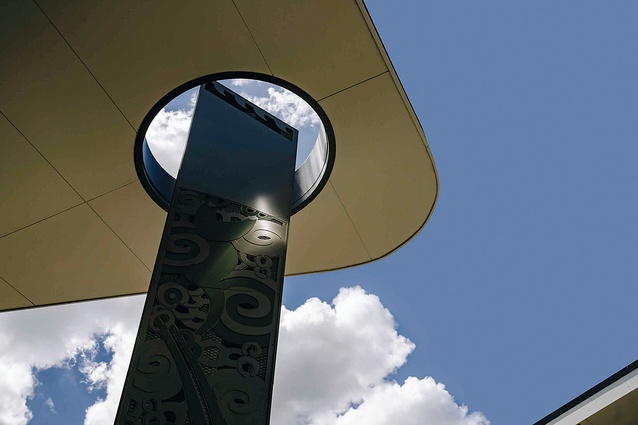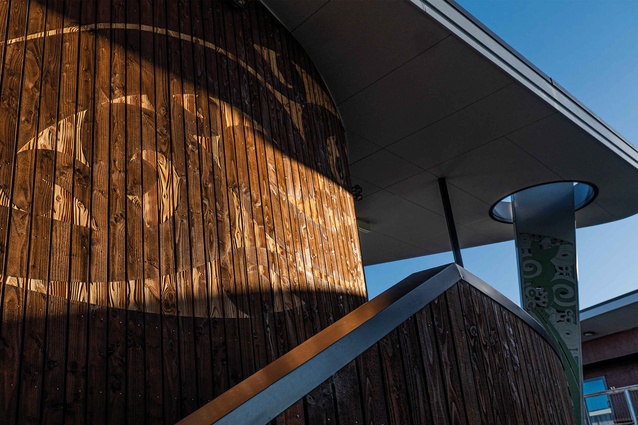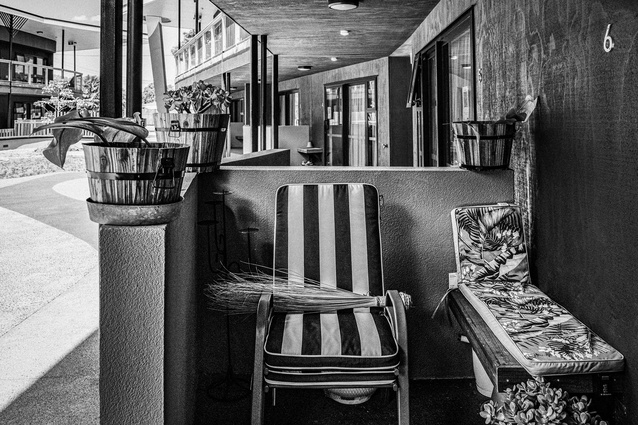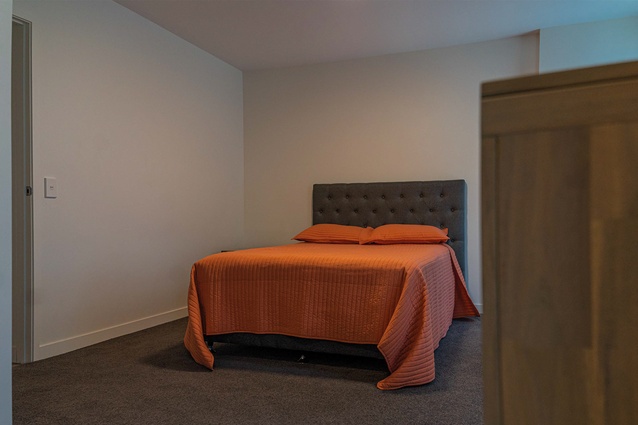Feel Māori, look Māori, be Māori
Karamia Müller visits Kōtukutuku Papakāinga, a Mahitahi Trust social housing project in Auckland's Ōtara, and finds TOA Architects has created a place of special significance, which welcomes, protects and fosters connections.
Kei te tua o Manukau, te kite ki muri, ki te kupenga o taramainuku — When you pass out beyond the Manukau waters, do not look back until you reach, or pass, the net of taramainuku. I open with this whakataukī (proverb) as a way to mihi (introduce) Kōtukutuku Papakāinga. It now embodies the proverb, which also mapped a course in the design process: that the design was to be a safety net for Mahitahi’s tangata whaiora (client base).
Kōtukutuku Papakāinga is a fit-for-purpose social housing project located in Ōtara, South Auckland, led by Mahitahi Trust, with design by TOA Architects. The Trust’s services support people and community in well-being journeys and rangatiratanga (the right to self-determination). The Papakāinga is made up of 40 single-bedroom, fully furnished apartments over two storeys, a whānau apartment, a Whare Manaaki (community building), office spaces and a gathering space with a central courtyard. Using CLT, rather than concrete, for floor and walls resulted in more-efficient construction, a lighter building, less concrete in the foundations and an overall reduction in embodied carbon. While the design innovations are impressive, in my quest to review the architecture, I found a story of resilience, leadership and vision.
My review is one that is fitting of the pandemic; we were forced to meet online but I drove past the Papakāinga to see the building for myself.
On the day we meet, rain is coming down in sheets across Tāmaki Makaurau. When I see Mahitahi Trust’s Tumu Whakarae (CEO) of 10 years, Raewyn Allan (Te Atihaunui a Pāpārangi), in the Microsoft Teams meeting, I am immediately struck by her warmth and conviction. Traci-Mae Nathan (Waikato-Tainui), Director for Ūkaipō and Tikanga for Mahitahi Trust, is equipped with an umbrella and mobile device, ready to walk me through the buildings and across the swirling concrete patterned courtyard, despite the heavy rain. After introductions, the virtual tour begins.
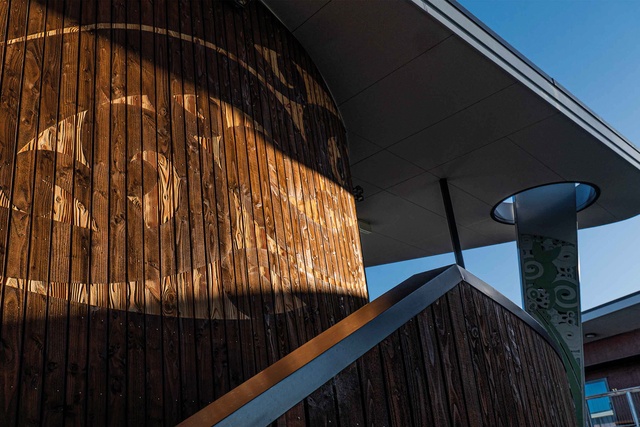

Graciously, Traci-Mae exits the warm interior to the outside, where she walks her camera over the rippled designs carved into the Douglas fir cladding, signifying the paddle strokes of a waka left on the water. The carved effect is a visually striking result of collaboration between TOA and an industrial design team to develop new decorative techniques in façade treatments. The vertical elements appear through the camera lens, surrounded by the grey mist of falling rain as if the surface of water. The unique windows appear like large dashes carved into the façade. It is a delightful choreography in composition, harmonising the sculptural quality of the fenestration with the mass of the two buildings. The wraparound verandahs and extended roof canopies lend the composition a lovely sense of relief, with negative spaces that bring balance to the more-solid forms. The courtyard creates a view shaft as well as a line of symmetry that emphasises the coming together of parts that are more than the whole.
When I enquire about any special moments during the design process, Raewyn offers me some whakapapa first. Indeed, this project is one of process, where people and their stories have begun and continue to layer upon one another, to create a storied place of home, where new and ongoing deep connections are made to both people and place.
Going right back to the start, Raewyn recounts that several years ago, Mahitahi recognised the systemic issue facing individuals who, in the event of emergency admissions to health services, would risk and often face the loss of their homes. The Trust knew it needed to respond to stop the revolving door from acute admissions to homelessness for its whānau. And so began the first step in the journey to Kōtukutuku Papakāinga.
The site, owned at the time by Housing New Zealand (HNZ), was where Mahitahi Trust started out more than 30 years ago; this is why it approached HNZ to purchase the property. Almost a year went by before confirmation came that it could buy the property. At the same time, the property next door came onto the market, so Mahitahi Trust purchased both. Looking towards the future, the Trust knew it didn’t want a cookie-cutter approach but wanted the Papakāinga to feel Māori, look Māori and be Māori. Its vision was a contemporary marae that actively responded to the social, cultural and well-being needs of today. Firm in its kaupapa, it collaborated with Julian Brown of Kauri Advisors, a specialist in stakeholder-centric property development consultancy; Raewyn emphasises that Brown was instrumental in bringing the project to life.
Working with Kauri Advisors, Mahitahi Trust set out to find the right architects to turn its vision into reality. Raewyn explains that, while many of the schemes presented in that process were adequate, it was the hand-drawn sketches by TOA associate and architectural designer Te Ari Prendergast (Te Whānauā Apanui, Ngāi Tahu, Ngāti Porou) that gave Mahitahi the confidence that TOA was the right team to design and facilitate its vision.

While listening to Raewyn recount this journey, I can view the central landscaped courtyard where the mauri stone, gifted by mana whenua, is buried. I am shown that the surface of the pavers creates patterning befitting this shared space, which fosters whanaungatanga (connection) between residents. I am told that, for this reason, the courtyard has a special significance to the Mahitahi whānau and is more than an open common space. At this point, Traci-Mae’s camera is turned so that I view the pou at the entrance of Kōtukutuku Papakāinga from within rather than from outside. This seems appropriate as Raewyn tells me that the pou have been installed to both protect and welcome their whānau. Even viewing them through the lens of a phone, I feel a sense of both protection and welcome from the gateway that is formed by the tall pou tilting towards each other.
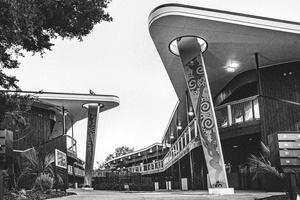
We move on to a ground-floor unit, which has views out onto the courtyard. I am informed that, as the project unfolded, the specific well-being needs of clients were woven into the design process. While they had not set out to create a palliative care unit within the wider housing brief, a whare whakamarie was included in the design. This was the result of one of Mahitahi Trust whānau receiving a diagnosis of terminal illness. Rather than place him in hospice care in an unfamiliar space with unfamiliar people, Mahitahi Trust turned a rumpus room in another whare into a marae-style space so that his whānau and their kaimahi could care for him during his last weeks. To honour him, a plaque has been installed on the entrance wall, weaving the whakapapa (genealogy) of those who have made a home at Kōtukutuku Papakāinga. While he is no longer with us, his story lives on in the building, a testimony to the commitment of Mahitahi to its constituents.
I am informed that this whare has been purposefully designed like the interior of a marae: open so that its carpeted floor may be filled with mattresses for visiting whānau. Cultural traditions have been attended to in the layout of the internal space; large concertina doors can separate the kai from the health-care activities. Tikanga (protocol) is honoured by keeping that which is noa (free from restrictions) from that which is tapu (sacred). Incorporating such principles into the building’s function recognises the significant role attending to traditional practices has in the well-being of Mahitahi whānau, and that the journey towards hauora (health) is one that connects people across time and space with whanaungatanga (kinship).
The virtual tour has arrived at the garden beds, the lush green of produce, bright against the greyness of the sky. The planting of the beds is based on rongoā (healing), continuing the commitment to the well-being of the papakāinga. There are also small trees planted, which, Raewyn comments, will grow to be mighty.
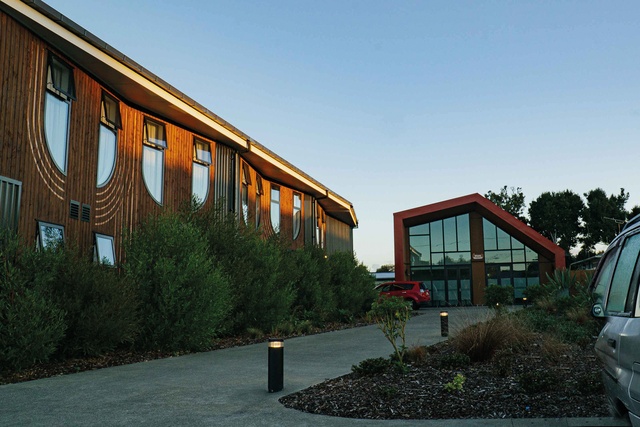
The Whare Manaaki, which is the communal space for gathering, kai (food), hui (meetings) and other events, has its entrance located adjacent to the garden beds, creating a sense of vibrancy to the circulation. It is a light, open space, accented with custom timber panels, carved by visual artist Todd Sheridan (Ngā Rauru), based in Tūranganui-a-Kiwa. The commercial kitchen is large and commodious, complete with stainless-steel benchtops. Raewyn tells me with what seems to be a smile: “many a good kai has been cooked here already.” I am reminded that a kitchen is only as good as the relationships it can nourish. Upstairs, I am shown two consulting rooms, located on a mezzanine; this space is for providing safe and highly accessible healthcare, social and financial services for Mahitahi whānau. Lastly, I am led to a meeting space, which is spacious and light filled, with fern-green carpeting and a view over the ground-floor area, connecting the spaces visually.
After our virtual tour, Raewyn asks Te Ari if he would like to share anything on the process. He comments that what stands out for him is that Mahitahi knew its people and what it wanted. And, that, while the architecture has been acknowledged in the Housing – Multi-Unit category for the 2022 Auckland Architecture Awards shortlist, it was that it was lived in and loved by people that made the building so special. It was the kaupapa that made the project important and demonstrated that the industry can do better by such communities.
Regarding the co-design process with Mahitahi, its clients, staff and tangata whaiora in a series of hui, he added that it was the leadership of Raewyn and her team in understanding the needs of their people which brought out the best in the design process, especially in discussions where disagreements arose. They also invested deeply in translating the design process for their whānau, creating feedback sessions where proposed building plans were recreated at 1:1 on the floors of their offices “so that whānau could walk in and look around and check that things were in the right places.” Everything from kitchen appliances to lighting underwent whānau consultation. As soft laughter bubbles up from the hui, recounting the stories that have brought them to this point, I feel the warmth of trust built from a journey travelled together through highs and lows. Finally, Raewyn concludes the tour saying that they always knew what they wanted: safe, warm and affordable housing that was pleasurable to live in, and that created spaces that were significant to whānau Māori and an environment where healing is a priority. Their design driver was that their people deserved nothing but the best. “We had a vision, we stuck to our vision and we moved mountains to do it.”
I would like to thank the Mahitahi Trust Board, especially Max Cribb (Ngāti Maniapoto, Ngāti Tamaterā, Ngāti Kauwhata) and Daniel Harrison (Ngāti Porou), for entrusting me with the responsibility of reviewing this building and hearing the stories of Kōtukutuku Papakāinga. And, I especially thank Raewyn Allan and Traci-Mae Nathan for facilitating the virtual tour.

